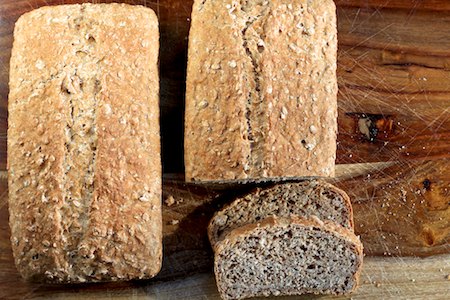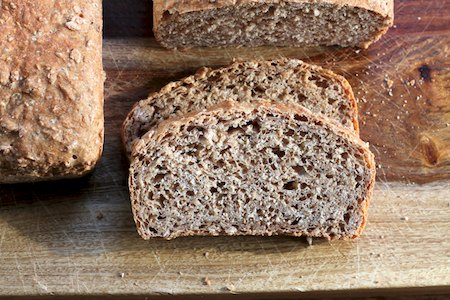
For this month’s Bread Baking Babes assignment, Astrid, our queen of spelt, chose a whole grain bread based on the writings of Hildegard of Bingen, 12th-century theologian, writer, healer, nutritionist, and, according to Astrid, the Middle Ages’ own spelt queen. According to Saint Hildegard, “Spelt creates healthy body, good blood and a happy outlook on life.” We can’t ask for much more than that, now, can we?
(Well, I might ask for one more thing: Astrid mentioned that Hildegard was a proponent of the healing power of jewelry. This is very good news! I am going to investigate this further and see if I can get my health insurance to pay for a pearl ring, or maybe an opal necklace.)
But back to the spelt bread. I really love the flavor of spelt; it is nuttier and less bitter than whole wheat. Because this is a 100% whole-grain bread (60% whole spelt flour and 40% spelt flakes), and because its gluten is not as strong as that of its cousin, wheat, this is a dense bread. However, it is moist and flavorful, and a perfect accompaniment for winter soup.

I found packaged spelt flakes in the hot cereal section of Whole Foods. The whole spelt flour was in the bulk section, but it is also sold in packages online or in the baking section of the market.
The recipe is as Astrid presented it, with my notes in italics. The other Babes (links in sidebar) will also provide you with useful tips in case you too would like a healthy body, good blood, and a happy outlook packaged in a tasty little loaf.
Hildegard’s Spelt Bread
400 grams spelt flakes
600 grams whole spelt flour
15 grams salt
40 grams fresh yeast [I substituted 16 grams instant yeast]
200 ml milk, lukewarm [I used nonfat milk]
500 ml water, lukewarm
2 tablespoons lemon juice
1 tablespoon sunflower oil
Mix spelt flakes and spelt flour with the salt. Dissolve yeast in milk and combine everything to a sponge. Cover the bowl with a kitchen towel and let rest for about 15-20 minutes. [This was an extremely dry and crumbly mixture. Don’t worry about it.]
Add water and lemon juice to the sponge and knead for at least 15 minutes gradually adding the sunflower oil. [I mixed by hand on the counter, with a dough scraper to help keep things more or less neat. At first the mixture was a gloppy mess. Don’t worry about it; it comes together quite a bit with mixing.]
Form doughball and coat with warm water. [Mine was still too slack to form a ball at this point. I just plopped it into a bowl.] Cover again with kitchen towel and let double in size. [I left it for about an hour.] Knead for another 2-3 minutes.
Cut dough in 2 equal halves and place each in a baking pan. [At this point the dough had enough body that I could pat it out into rectangles on a floured counter and roll them up into logs. I used 9 x 5-inch pans but 8 x 4 would have been better, yielding taller loaves.] Cut the surface of both breads about 5 mm deep and let rise again until doubled in size. [I left it for about 30 minutes, which was slightly too long.]
Bake the first 15 minutes at 200 °C [400F], then lower heat to 195 °C [385F] and bake for another 30 minutes.
Astrid’s notes:
– The longer you knead the dough, the more air will be incorporated – but be careful not to overknead the dough! [This is why I mixed by hand.]
– You can also soak the spelt flakes in the lukewarm milk a while before you assemble the sponge, if you prefer.
– Be careful that the dough will not overrise, especially at the last rising step. Spelt loves to overrise if you are not careful enough.
– It’s recommended to place a bowl with water into the oven for the first 15 minutes of baking. [I used my usual steaming method.]
– You can also brush the finished bread with some milk and let dry for about one minute in the oven.
Love how your bread looks. Just went and read about your steaming method(s) and am amazed! Need to try that too!!
Looks wonderful! You got great shape on the top.
Wow, this spelt bread looks so yummy. Thank you for the inspiration, (I will be a bread baking buddy this month) and for wonderfully helpful italics. I love your write-ups, Susan. Can’t wait for the BBB round-up.
As always Susan, your thoughts on the recipe are great. Love the crust and nice dome you got on the loaf.
Beautiful write up and beautiful spelt bread. The flavor really is wonderful. Your loaves look just perfect!
How did I miss that about the healing powers of jewellery?! (It must have been because I got distracted by learning that St.Hildegard was an accomplished composer.)
Congratulations on getting the bread to form a crown. I must have let mine rise too much so it is flat as a pancake (looks like it was baked in a pullman tin).
Hmm, I didn’t know that you like jewelry 🙂 ….
I haven’t had any chance to make this wonderful sounding bread. I am quite tempted, especially with spelt flour.
I have been wondering if spelt would make a good bread. I am always trying to find new grains to make baked goods with. There are so many options out there, but this bread looks beautiful, I will definitely give the recipe a try.
How could anyone say bread could be bad for you when there is such history to grain and what has been done to it over the millennia. Wonderful spelt recipe. Pearl’s and opals sound good. Better than a test any old time.
That is a gorgeous spelt bread. I’d go for the pearls….
I have a bunch of food allergies and have tried for three years to work with Spelt flour to make my own bread. Thank you, thank you, thank you. I finally found someone who is an expert to help me transition to spelt flour baking. The economy where I live is pretty bad and I am disabled so thank you for helping me find an expert on how to bake with spelt and spelt flakes.
Sincerely,
Multiple food allergies in Michigan
Do you grease the loaf pans? If so, with what kind of grease? And, if so, do you also dust them in flour after having greased?
Thanks!